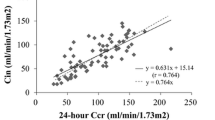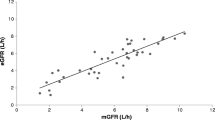Abstract
The renal clearance of endogenous creatinine is widely used to assess glomerular filtration rate (GFR) and renal function in animal investigations. The objective of the present investigation was to evaluate the extent of renal secretion of endogenous creatinine in rats and the effect of probenecid, the classical inhibitor of organic anion transport, on creatinine clearance. Ten female Lewis rats received 3H-inulin (5-µCi i.v. bolus followed by 5 µCi/hr) throughout a 6-hr period. Three hours after initiation of the inulin infusion, probenecid was administered (92.4-mg/kg i.v. bolus followed by 0.59 mg/min/kg). Steady-state serum concentrations of about 500 µg/ml probenecid were achieved. Renal clearance was assessed between 1 and 3 hr (control) and between 4 and 6 hr (probenecid treatment). A preliminary study in seven rats demonstrated no time-dependent change in inulin or creatinine clearance between these two study intervals. Creatinine clearances were determined by an alkaline picrate assay which incorporated Fuller's earth (Lloyd reagent) to remove interfering noncreatinine chromogens from serum samples and these values were compared with those using a nonspecific picrate assay. “True” clearance ratios of creatinine to inulin (CLcr/ CLin) were greater than unity (2.33 ± 0.83, mean ± SD) and were significantly decreased after probenecid treatment (1.26 ± 0.28, P < 0.01). Probenecid had no effect on GFR, as assessed by inulin clearance. Using the nonspecific picrate assay, CLcr/CLin was 1.12 ± 0.41, which was not significantly different from unity and which decreased to 0.53 ± 0.12 after probenecid treatment. Therefore, creatinine undergoes extensive renal secretion in female Lewis rats.
Similar content being viewed by others
REFERENCES
J. H. Bauer, C. S. Brooks, and R. N. Burch. Clinical appraisal of creatinine clearance as a measurement of glomerular filtration rate. Am. J. Kidney Dis. 2:337–346 (1982).
A. S. Levey, R. D. Perrone, and N. E. Madias. Serum creatinine and renal function. Annu. Rev. Med. 39:465–490 (1988).
S. Narayanan and H. D. Appleton. Creatinine: A review. Clin. Chem. 26:1119–1126 (1980).
M. H. Meyer, R. A. Meyer, Jr., R. W. Gray, and R. L. Irwin. Picric acid methods greatly overestimate serum creatinine in mice: More accurate results with high-performance liquid chromatography. Anal. Biochem. 144:285–290 (1985).
D. C. Houghton, J. English, and W. M. Bennett. Chronic tubulointerstitial nephritis and renal insufficiency associated with long-term “subtherapeutic” gentamicin. J. Lab. Clin. Med. 112:694–703 (1988).
U. F. Michael, J. Kelley, and C. A. Vaamonde. Effects of aldosterone, methylprednisolone and triiodothyronine on the response to water loading in the conscious hypothyroid rat with diabetes insipidus. Mineral Electrolyte Metab. 10:190–198 (1984).
P. Namnum, K. Insogna, D. Baggish, and J. P. Hayslett. Evidence for bidirectional net movement of creatinine in the rat kidney. Am. J. Physiol. 244:F719–F723 (1983).
G. Peters. Glomeruläre clearancen, p-aminohippursäureclearance und diurese bei verschiedenen diureseformen der nicht narkotisierten ratte. Naunyn-Schmied. Arch. Exp. Path. Pharmakol. 235:113–142 (1959).
L. Glasser. Renal excretion of creatinine in the rat. Am. J. Physiol. 200:167–169 (1961).
A. M. Harvey and R. L. Malvin. Comparison of creatinine and inulin clearances in male and female rats. Am. J. Physiol. 209:849–852 (1965).
M. Friedman. The creatinine, inulin and hippurate clearance in the rat. Am. J. Physiol. 148:387–391 (1947).
E. Fingl. Tubular excretion of creatinine in the rat. Am. J. Physiol. 169:357–361 (1952).
B.-M. Emanuelsson and L. K. Paalzow. Dose-dependent pharmacokinetics of probenecid in the rat. Biopharm. Drug Disp. 9:59–70 (1988).
D. Heinegard and G. Tiderstrom. Determination of serum creatinine by a direct colorimetric method. Clin. Chim. Acta 43:305-310 (1973).
R. Haeckel. Assay of creatinine in serum, with use of Fuller's earth to remove interferents. Clin. Chem. 27:179–183 (1981).
K. S. Bjerve, J. Egense, L.-M. Lampinen, and P. Masson. Evaluation of several creatinine methods in search of a suitable secondary reference method: Report from the subcommittee on reference method for creatinine, Nordic Society for Clinical Chemistry. Scand. J. Clin. Lab. Invest. 48:365–373 (1988).
R. K. Harle and T. Cowen. Determination of probenecid in serum by high performance liquid chromatography. Analyst 103:492–496 (1978).
R. F. Pitts. Physiology of the Kidney and Body Fluids, Year Book, Chicago, 1968, pp. 62–70.
Y. Gutman, C. W. Gottschalk, and W. E. Lassiter. Micropuncture study of inulin absorption in the rat. Science 147:753–754 (1965).
B. J. Carrie, H. V. Golbetz, A. S. Michaels, and B. D. Myers. Creatinine: An inadequate filtration marker in glomerular diseases. Am. J. Med. 69:177–182, 1980.
W. L. Chiou. Creatinine XI. Extensive renal tubular reabsorption and secretion in man and its clinical significance. Res. Commun. Chem. Pathol. Pharmacol. 36:349–352 (1982).
S. T. Wolford, R. A. Schroer, F. X. Gohs, P. P. Gallo, M. Brodeck, H. B. Falk, and R. Ruhren. Reference range data base for serum chemistry and hematology values in laboratory animals. J. Toxicol. Environ. Health 18:161–188 (1986).
H. R. Lam and F. Tarding. Specific high-performance liquid chromatographic method for the determination of creatinine in rat plasma. J. Chromatogr. 426:358–364 (1988).
S. V. Shah and P. D. Walker. Evidence suggesting a role for hydroxyl radical in glycerol-induced acute renal failure. Am. J. Physiol. 255:F438–F443 (1988).
M. J. Radin, W. L. Wilke, and M. J. Fettman. Dose effect of captopril on renal hemodynamics and proteinuria in conscious, partially nephrectomized rats. Proc. Soc. Exp. Biol. Med. 190:294–300 (1989).
B. Odlind, R. Hällgren, M. Sohtell, and B. Lindström. Is 125I-iothalamate an ideal marker for glomerular filtration? Kidney Int. 27:9–16 (1985).
A. K. Grzybowski and S. P. Datta. The ionisation constant of the protonated form of creatinine. J. Chem. Soc. 187–196 (1964).
B. R. Rennick. Transport mechanisms for renal tubular excretion of creatinine in the chicken. Am. J. Physiol. 212:1131–1134 (1967).
J. M. B. O'Connell, J. A. Romeo, and G. H. Mudge. Renal tubular secretion of creatinine in the dog. Am. J. Physiol. 203:985–990 (1962).
H. Bucht. On the tubular excretion of thiosulphate and creatinine under the influence of caronamide. Scand. J. Clin. Lab. Invest. 1:270–276 (1949).
B. Crawford. Depression of the exogenous creatinine/inulin or thiosulfate clearance ratios in man by diodrast and p-aminohippuric acid. J. Clin. Invest. 27:171–175 (1948).
F. Berglund, J. Killander, and R. Pompeius. Effect of trimethoprim-sulfamethoxazole on the renal excretion of creatinine in man. J. Urol. 114:802–808 (1975).
N. V. Olsen, S. D. Ladefoged, B. Feldt-Rasmussen, N. Fogh-Andersen, H. Jordening, and O. Munck. The effects of cimetidine on creatinine excretion, glomerular filtration rate and tubular function in renal transplant recipients. Scand. J. Clin. Lab. Invest. 49:155–159 (1989).
Author information
Authors and Affiliations
Rights and permissions
About this article
Cite this article
Darling, I.M., Morris, M.E. Evaluation of “True” Creatinine Clearance in Rats Reveals Extensive Renal Secretion. Pharm Res 8, 1318–1322 (1991). https://doi.org/10.1023/A:1015820316660
Issue Date:
DOI: https://doi.org/10.1023/A:1015820316660




